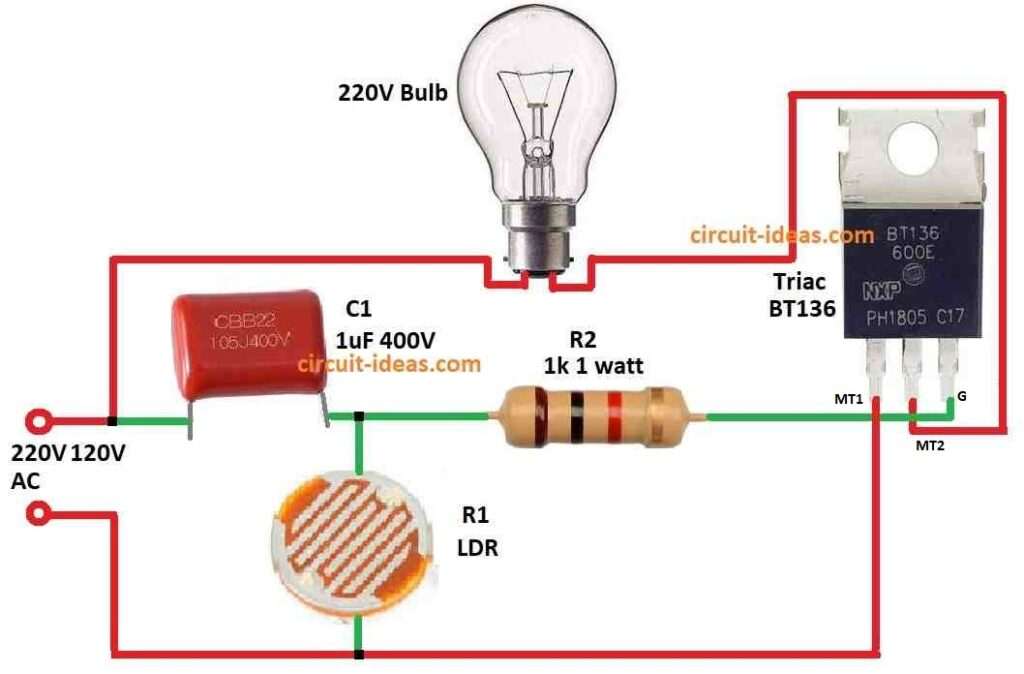Simple Day Night Activated Switch Circuit using a Triac and LDR show how to make circuit which turns ON and OFF things by seeing outside light.
We only need one light sensor (LDR), one resistor, one capacitor and one special switch called Triac.
This circuit are used many time for alarm it turns ON light at night and OFF in day.
No need for extra motor or switch it work at home with normal electricity.
WARNING: Be careful working with high voltage can be dangerous.
Do it with adult or someone who know how to do electric work safe.
Circuit Working:

Parts List:
| Component | Description | Quantity |
|---|---|---|
| Resistor | ||
| 1k 1 watt | 1 | |
| LDR | 1 | |
| Capacitor | ||
| PPC 1uF 400V | 1 | |
| Semiconductors | ||
| Triac BT136 | 1 | |
| Bulb 220V | 1 |
This day night switch circuit uses triac and LDR, it is very simple and cheap to make and is easy also.
But one problem it is strong (solid) and does not allow to change or control electronic way.
It is not like normal switch it uses Triac or SCR which is not for mechanical one.
Many idea are made already made to turn ON light when dark comes.
Normally it need electromechanical relay and DC power.
But this one connect direct to AC power so less parts needed.
LDR is very important in this circuit because it change resistance by light.
In Quebec at night it show around 200 ohm and in day few thousand ohm.
It depend how much light comes.
LDR and Triac gate get power from capacitor C1 and this work like voltage divider.
When light is normal voltage goes down because LDR resistance goes down.
At night LDR resistance goes up so Triac get more current and turns ON light.
Formulas:
To make Day Night Switch we can build circuit that turn ON or OFF 220V bulb depending how much light LDR sees.
The circuit uses special formula for connecting parts.
We can find voltage across LDR (VLDR) like this:
VLDR = Vsupply × RLDR / (RLDR + Rfixed)
where:
- Vsupply is power given to LDR and resistor.
- RLDR is resistance of LDR which changes with light.
- Rfixed is normal resistor and in this circuit it is 1k ohm.
Capacitor Working:
The 1µF capacitor C help to smooth or control voltage.
Capacitor charge in time is like this formula:
R × C = t
where:
- t is time to charge which is called time constant
- R is resistance in same line with capacitor
- C is value of capacitor.
How fast this happen depend on how much light LDR sees.
How to Build:
To build a Simple Day Night Activated Switch Circuit using a Triac and LDR following steps are mentioned below for connections:
Triac Connection:
- Connect triacs MT1 and MT2 to AC mains power.
Resistor and LDR:
- Connect MT1 of triac to one leg of LDR.
- Connect one end of resistor to other leg of LDR.
- Then connect resistors other end to triac gate.
Capacitor Connection:
- Connect one leg of capacitor C1 to where LDR and resistor meet.
- Connect other leg of capacitor to MT2 of triac.
Diac Connection:
- One leg of diac connect to triac gate.
- Other leg of diac join at point where LDR, resistor and capacitor meet.
- For show ON/OFF connect LED between MT1 and MT2 of triac.
Power Source:
- Connect full circuit to AC mains power.
Key Points:
- Check all wires and parts are safe with no short circuit.
- Be careful while working with AC mains power.
- Choose correct parts and check datasheets before using.
Conclusion:
In Simple Day Night Activated Switch Circuit using a Triac and LDR after all is connected, circuit will turn OFF light in day and turn ON at night by itself.
We can change resistor value or try different LDR to match light level in our place.
Better to check datasheet or ask someone who know electronics.
References:
Can I use a TRIAC as an AC switch and an LDR as a switch controller to turn on and off a LED bulb?
Leave a Reply